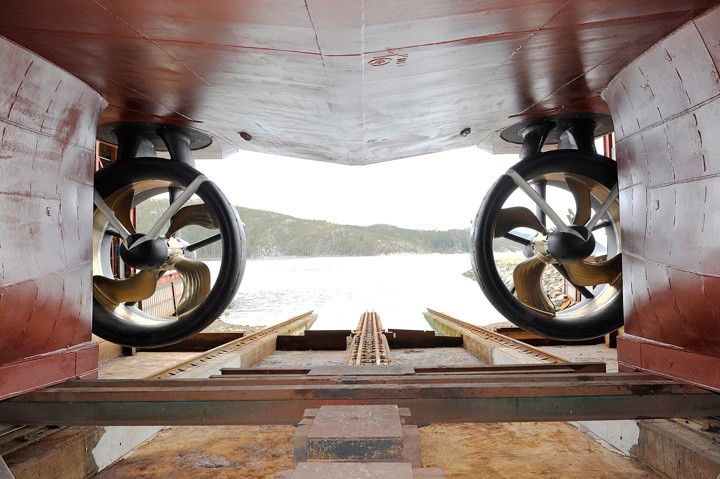. On the inside of the thruster shroud, the spinning hub of the rotor can be seen, to which the thruster blades are attached, Image: Rolls-Royce
After over a decade of research and development, Rolls-Royce is heading into full production of their permanent magnet tunnel thruster from their facility in Ulsteinvik, Norway. At the same time, the company is also introducing to the market a permanent magnet azimuth thruster.

- Related Book: Marine Propeller and Propulsion by John Carlton
A permanent magnet drive is different from a typical thruster in that the blades are not turned by a motor or gears located at the center of the thruster hub, but rather from the interaction of a stator located in the rim of the thruster – which carries a number of electrical coil windings – and the rotor which is fitted with a number of very strong permanent magnets and to which the propeller blades are affixed.
With no gears or external motor, Rolls-Royce notes the internal footprint of their tunnel thruster is far smaller than that of a typical thruster which would allow it to be installed farther forward or aft in a new ship – thus providing greater thrust moment port and starboard. In addition, the thrust in either direction is the same with this system.
It is important to note that Rolls-Royce isn’t the only company rolling out permanent magnet tunnel thrusters, however their design features a central hub that they say provides greater reliability and at the same time greater thrust efficiency.
For the past few years, Rolls-Royce has also been testing a new PM azimuth thruster concept on the 31 meter research vessel R/V Gunnerus. Tests of the two 500 kW thrusters (pictured above) have shown efficiency increases of between 7 to 13 percent at normal cruising speeds of the vessel.
Admittedly, this technology is not cheap, and Rolls-Royce says owners can expect about a 100% markup at the moment on PM azimuth thrusters compared to conventional systems, however the advantages could provide a compelling argument, namely:
- They are very responsive – it takes 6 seconds to go from full ahead RPMs to full astern RPMs.
- Very few moving parts means very little maintenance – up to 50 percent less according to Rolls-Royce
- Less moving parts results in 50 percent less noise as compared to a conventional system
- Greater hydrodynamic efficiency due to smaller, optimized central hub
- High torque density
- Higher efficiency over the entire speed range.
Looking ahead, Rolls-Royce is aiming at upscaling this technology at targeting the cruise sector. At the moment however, PM azimuth thrusters will be offered at 1MW, and the PM tunnel thrusters in 1.6 MW and 1MW power ranges.

 Join The Club
Join The Club












